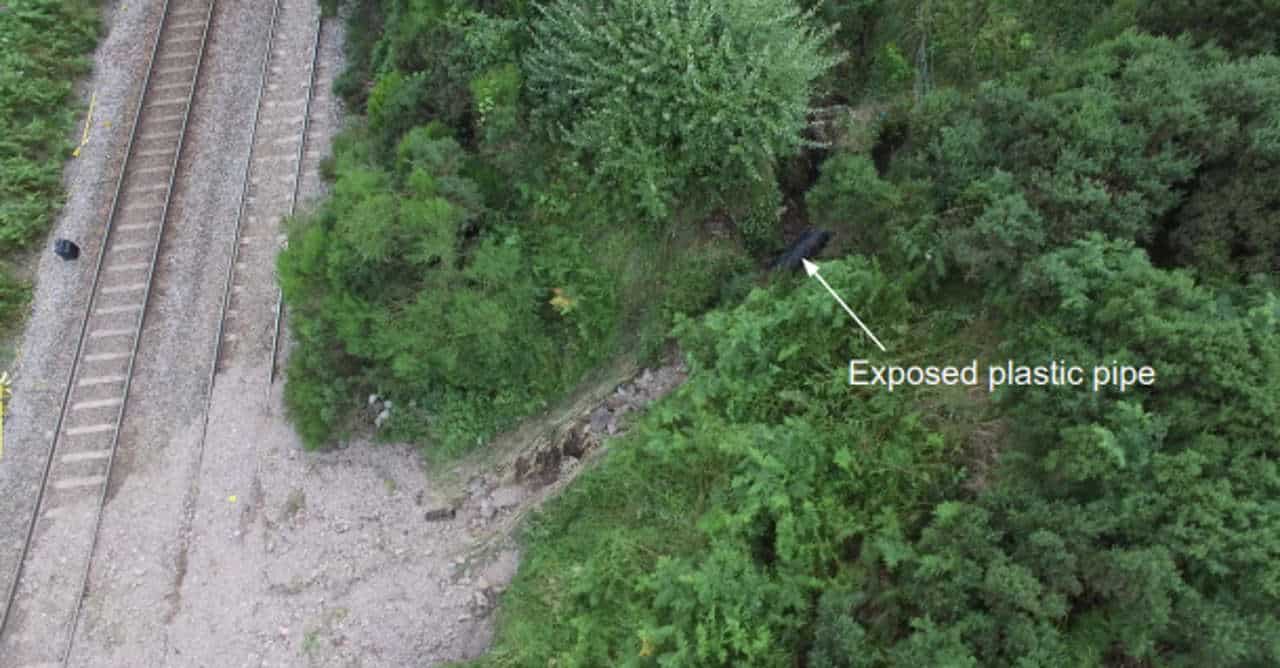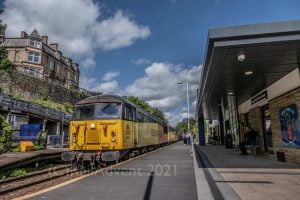The Rail Accident Investigation Branch has released a new Interim Report covering their findings of the Stonehaven rail crash.
Back on the 12th August 2020, a ScotRail HST collided with washed-up debris near Carmont following heavy rainfall, resulting in the death of three people (the driver, conductor and a passenger), as well as causing injury to six other people.
Consisting of two power cars and four Mark 3 coaches, the HST was operating 1T08 0638 Aberdeen to Glasgow Queen Street ScotRail service but was returning to Aberdeen due to the weather at the time of the accident.
9 people were on board the train at the time of the accident, a driver, conductor, six passengers and another conductor travelling to join another train, passenger levels were light due to local travel restrictions which were in place at the time of the accident.
Whilst large amounts of rain had fallen, with continuous heavy rain falling up until around 9 am on the morning of 11th August, the weather when the train approached the accident site was bright and sunny.
Back in 2009, Network Rail instructed Carillion Construction Ltd to undertake improvement works including a new drain as the existing crest drain was not functioning effectively.
The drain ran for around 340 metres and had pipe buried in a gravel trench, the pipe had perforations to allow water to seep through the gravel and into the drain.
On the day of the accident, heavy rain caused lots of delays and closures to the railway, such that, by 7 am, the only major route in the Central and Eastern parts of Scotland was the Inverness – Aberdeen – Dundee line.
The first departures from Aberdeen, the 05:06 and 05:36 services, departed Aberdeen on time and passed through Carmont without problems, these were 2B12 and 1T06 respectively, the latter redesignated to 5T06 as it ran without any passengers.
1T08 departed Aberdeen on time and called at Stonehaven at 06:53 before continuing to Carmont where it was stopped by the signallers due to reports of a landslip north of Ironies Bridge.
Reversal of 1T08 took place at Carmont, with no facing locks, temporary locks were needed, so a Mobile Operations Manager, based in Aberdeen had to travel to secure the crossover, but experienced difficulty in reaching Carmont, arriving at around 08:55.
Heavy rain at Bridge 325 between 05:50 and 09:00 resulted in the gravel around the crest drain as well as stone and soil being washed onto the track, the RAIB says it is not known when this occurred, but this would have been between 07:07 and 09:37, the time between the last train passing through without a problem and 1T08 arriving at the location.

Data from 1T08 showed that it was travelling at 73mph, less than the permitted 75mph. It was travelling at this speed as the signaller at Carmont was not aware of any obstructions, he used the crossover at Carmont (at the signaller-permitted 5mph), before increasing the speed back up to 75mph.
When the train hit the debris, the leading power car derailed and deviated towards the cess, running for around 60 metres before it hit the bridge parapet, causing the power car to fall off the bridge and down the embankment. The driver’s cab became detached on impact with the ground.
The first carriage came to rest on its roof at a near right angle with the track, whilst the second carriage came to rest on its roof with its rear end on top of the first coach, after spinning 180 degrees.
The third coach came to rest on its right-hand side, whilst the fourth coach remained upright but came to rest on top of the first coach, the rear power car remained on the downline, attached to the fourth coach.
On train CCTV and witness accounts show the power car on fire, which the RAIB says was caused by fuel spillage from the ruptured fuel tank. Coach B also caught fire but no one was inside this coach, and no injuries were sustained as a result of either fire.
The RAIB has said that even if an Extreme Weather Action Teleconference, or EWAT, had taken place, it was unlikely the accident would have been avoided as it did not require “any mitigation to be applied at or near the site of the accident”. It also said that at the time of the accident, Network Rail had no formal procedure requiring an immediate review of restrictions after multiple weather events, such as those seen at Laurencekirk and Newtonhill on the morning of the accident.
The RAIB says that they will publish their complete findings, and any recommendations, when they have finished the investigation.
The full 29-page report can be viewed here.
Where Next?
RAILADVENT NEWS
The latest railway news
FREE NEWSLETTERS
Signup to our daily and weekly newsletters
RAILADVENT SHOP
Railway Prints, DVD’s / Blu-Ray’s, books and more
LOCOSTOP COMMUNITY
Come and share your railway pictures
UK STEAM INFO
Upcoming mainline steam tours/loco movements





Responses